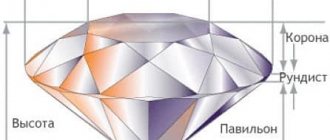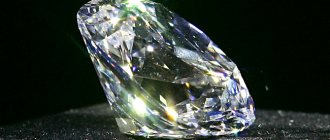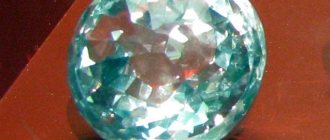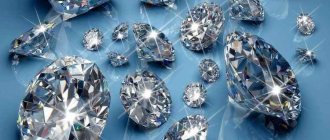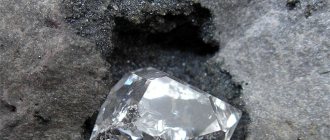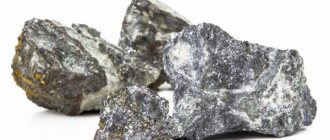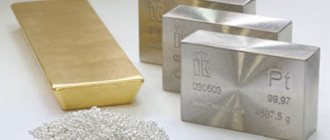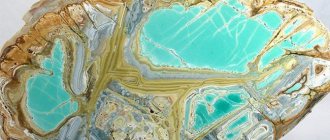Twice the largest diamond
The largest diamond (cut diamond) in the modern world is the Golden Jubilee . The diamond got its name in honor of King Bhumibol Adulyadej (Rama IX) of Thailand. The stone was presented to the king by his subjects in 1997 in honor of the 50th anniversary of his coronation. In addition to being the largest diamond, the Golden Jubilee is also the largest brown diamond in the world .
Lesedi la Rona, 1109 carats
In November 2015, Lucara Diamond Corporation mined another gem in Botswana - an incomparable diamond weighing 1,109 carats (222.2 grams). It was originally thought to contain 1,111 carats.
The stone, named Lesedi la Rona, is currently the second largest in the world in terms of mass and size of all previously discovered diamonds. In September 2021, the gem was sold to ]Graff Diamonds[/anchor] for $51 million.
Huge diamond: the history of the stone
The diamond from which the Golden Jubilee was cut was found in South Africa in 1985 at the Premier mine in the Transvaal, owned by De Beers. It should be noted that this particular mine is the “homeland” of such famous diamonds as Cullinan - the largest of the diamonds, Century, Niarchos, Taylor Barton and several others. The found diamond weighs 755 carats and ranks 8th in size gem-quality diamonds ever discovered
In cutting the Golden Jubilee, De Beers was the first to use the latest tools and equipment designed specifically for producing large diamonds. The diamond had cracks and inclusions, which made working on it very difficult. After much debate, De Beers appointed Gabriel Tolkowsky, nephew of the famous cutter Marcel Tolkowsky, inventor of the classic round brilliant cut, to be in charge of cutting. Work on the diamond was carried out in a specially built underground room, which eliminated the slightest vibration. Cutting the stone began in May 1988 and took two years.
Jubilee Diamond (245.35 carats)
Originally, this incredibly beautiful Jubilee Diamond was an irregularly shaped octahedron measuring 650.8 carats. As a result, it was possible to obtain a stunning diamond weighing 245.35 carats, and from the remaining part a pandelok weighing 13.34 carats.
Throughout its history, the stone has had several owners, and as a result it was purchased for the Washington Smithsonian Institution and presented to the public there.
The E grade stone was cut and polished in Amsterdam. It is classified as a colorless E grade diamond. Its exact price is still unknown.
Characteristics of the largest diamond
In May 1990, Gabriel Tolkowsky presented his creation - the world's largest cushion-cut diamond with rose-cut elements. Gabi himself calls its unusual cut “cushion fire rose . The diamond has a completely symmetrical 55 facets of the top (crown), 64 facets of the bottom (pavilion) and 24 facets of the girdle (girdle). “Golden Jubilee” has an unusual (fancy) yellow-brown color. The purity of the stone is unknown. Probably, due to its characteristics, the stone belongs to the rare type Ib diamonds. The cut diamond weighs 545.67 carats , which places the Golden Jubilee at the top of the list of the largest diamonds in the world.
For almost the entire 20th century, this place was occupied by the Cullinan I or Star of Africa diamond, which weighs 530.20 carats.
Red Cross Diamond (205.07 carats)
The ninth largest diamond in the world is called the Red Cross Diamond . The stone is a canary yellow cushion diamond from the De Beers Kimberley mines in South Africa and weighs 205.07 carats.
The original rough stone was found in 1901 and is said to weigh around 375 carats. Canary yellow diamonds are extremely rare. While 98% of all diamonds contain nitrogen as an impurity, canary yellow diamonds contain these nitrogen impurities only as individual atoms in the chemical structure and not as clusters of two, three or four atoms.
These single nitrogen atoms absorb visible light at the blue end of the spectrum, thus producing an intense yellow color known as canary yellow. This occurs in only 0.1% of all diamonds. Another interesting feature of these stones is that they fluoresce.
The largest diamond gets its name
The diamond that appeared did not have any name, so it was simply called the Unnamed Brown Diamond . Under this name, the stone was shown at several exhibitions, including the Thai Board of Investment exhibition, where it was brought by the Thai Diamond Manufacturers Association. The exhibition was a great success; large queues lined up to see the unusual diamond.
Thailand is one of the few countries in the world where the political system is a constitutional monarchy, and the ruling king enjoys great authority. In 1997, Thailand was preparing to celebrate the 50th anniversary of the reign of its beloved king and a group of businessmen, led by the famous diamond seller Henry Ho, decided to present a diamond as a gift to the monarch. In 1995, the diamond was purchased from De Beers and exhibited at the Henry Ho jewelry shopping center in Bangkok. Before the presentation, the diamond was shown to Pope John Paul II, the Supreme Buddhist Patriarch and Supreme Muslim Imam of Thailand, and received their blessing. The Nameless Brown was presented to the King in 1997 and received his new name, Golden Jubilee .
It should be noted that Thailand was experiencing an economic crisis at that time, and in order not to worry fellow citizens, the government announced that the gift received was not a diamond, but a large golden topaz. There were plans to set the stone into a royal scepter or royal seal, but for now it remains unmounted. The world's largest Golden Jubilee Diamond is currently on display in the Throne Room of the Golden Temple at the Royal Museum in Bangkok.
Follow JEWELIRUM news in the usual format of your social media feed: VKontakte, as well as on Facebook
PRECIOUS STONES DIAMONDS
Who came up with the “Dancing Diamond” mounting method?
What are "black diamonds"?
Koh-i-Noor (317.4 carats)
This is one of the largest diamonds in the world, which differ in color. Initially it had a barely noticeable yellow tint, but after a series of cuts the stone acquired a white color.
During the period of Mongol raids, the wife of an Indian ruler exchanged the stone for the life of her beloved husband. The delightful diamond traveled around the East for many years until fate brought it to India again. In the mid-19th century, this state became an English colony. Then the beautiful Koh-i-Noor began to belong to Queen Victoria. Since then, Great Britain has been its rightful owner, although from time to time the Indian authorities ask to return the jewel to their homeland.
Interesting fact: negative magical properties have been attributed to this gemstone throughout its existence. According to legend, it brings misfortune to its owners if they take possession of it illegally.
Wittelsbach diamond
The Wittelsbach is a 31.06-carat (6.212 g) blue diamond that was set into the Bavarian crown in the 19th century and belonged to the German feudal Wittelsbach family before World War I. It was lost during the war. In 2008, Christie's auction house sold the diamond to British jeweler Laurence Graff for the then-record amount ever received for a diamond: 16 million 393 thousand 250 pounds sterling ($24,311,190). In June 2011, the Wittelsbach Diamond was purchased by the Emir of Qatar, Hamad bin Khalifa Al Thani, for $80 million .
6
LiveInternetLiveInternet
Thursday, February 26, 2015 10:05 + in the Otrada
all posts by the author The Golden Jubilee is the largest diamond in the world. This fancy yellow-brown diamond weighed 755.5 carats before cutting. After the famous cutter Gabi Tolkowski took on it, it turned out to be a diamond of unprecedented beauty and size, weighing 547.67 carats. This is 17 carats more than another famous diamond, the Cullinan I, which has long held first place as the largest diamond in the world. "Golden Jubilee" was found in 1985 in the South African Premier mine, owned by the famous. For a long time this stone was not cut; cutting began only in 1990. It took 2 years to cut this unique diamond. To obtain this uniquely beautiful diamond, the company decided to use the latest technology at that time. The result exceeded all expectations, the stone attracted a lot of public attention, there was even a case in Thailand when the line of people wanting to look at this stone exceeded the length of 1 mile. In 1995, the diamond was bought by a group of Thai entrepreneurs for an immodest sum. It was never advertised to the public. The diamond itself was presented in 1997 to King Bhumibol Adulyadej of Thailand on his 50th coronation anniversary. Hence the name of the stone – “Golden Jubilee”. But before the stone was presented to the monarch, it was blessed by Pope John Paul II, then the Supreme Buddhist Patriarch and the Supreme Muslim Imam of Thailand. The unique owner is King Bhumibol Adulyadej of Thailand. King Bhumibol Adulyadej of Thailand The owner of the largest diamond in the world is a unique personality. To date, Bhumibol Adulyadej is the longest reigning active head of state and of all monarchs in the history of Thailand. He is also the only monarch with dual citizenship (born in the USA). In his country he is revered almost as a demigod, and his birthday is a public holiday. According to the official version, Bhumibol Adulyadej is also the richest monarch in the world. He initiated more than 3,000 projects to improve the country's infrastructure and economic development, especially in the poorest provinces of Thailand. In 2000, he received the title of Father of Thai Science. Patents on artificial rain technologies and a new type of fuel are registered in his name. Among other things, the Thai monarch is interested in music, agronomy, painting, photography (he is even depicted on a banknote with a camera, see the image above). Bhumibol also writes works and even published one comic book, which was immediately sold out. So the largest diamond in the world has found a worthy owner. Today, the Golden Jubilee is part of the Thai Crown Jewels, and everyone can view it at the Bangkok Royal Museum.
| Categories: | applied creativity interesting articles |
Tags:
jewelry diamonds
Cited 6 times Liked by 12 users
Like share
0
Like
- 12
I liked the post - Quoted
- 0
Saved
- Add to quote book
- 0
Save to links
Liked12
0
